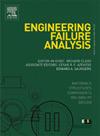Application of inverse heat transfer to fatigue fracture
IF 4.4
2区 工程技术
Q1 ENGINEERING, MECHANICAL
引用次数: 0
Abstract
Cyclic actuation tends to cause self-heating in the material as the structure experiences fatigue, where the movement and coalescence of defects lead to crack formation, propagation, and eventual fracture. This study explores the modeling aspects of the self-heating phenomenon using a one-dimensional inverse heat problem to analyze heat generation and dissipation to quantify the plastic work rates needed for predicting fatigue life. The approach is based on analyzing the surface thermography obtained using an infrared camera and numerically solving an inverse Fourier heat conduction equation. Formulation of the inverse problem via constrained optimization and method of solution for analyzing the fatigue behavior of CS 1018 flat dog bone specimens subjected to fully reversed bending fatigue are presented. The proposed model demonstrates superior accuracy in predicting the location of maximum heat generation and identifying potential fracture zones compared to traditional methods.
反热传导在疲劳断裂中的应用
当结构出现疲劳时,循环致动往往会导致材料自热,缺陷的移动和聚集会导致裂纹的形成、扩展和最终断裂。本研究探讨了自热现象的建模问题,使用一维逆热问题分析热量的产生和耗散,以量化预测疲劳寿命所需的塑性加工率。该方法基于对使用红外摄像机获得的表面热成像进行分析,并对反傅里叶热传导方程进行数值求解。文中介绍了通过约束优化和求解方法对 CS 1018 扁平狗骨试样进行反向弯曲疲劳行为分析的逆问题公式。与传统方法相比,所提出的模型在预测最大发热位置和识别潜在断裂带方面具有更高的准确性。
本文章由计算机程序翻译,如有差异,请以英文原文为准。
求助全文
约1分钟内获得全文
求助全文
来源期刊

Engineering Failure Analysis
工程技术-材料科学:表征与测试
CiteScore
7.70
自引率
20.00%
发文量
956
审稿时长
47 days
期刊介绍:
Engineering Failure Analysis publishes research papers describing the analysis of engineering failures and related studies.
Papers relating to the structure, properties and behaviour of engineering materials are encouraged, particularly those which also involve the detailed application of materials parameters to problems in engineering structures, components and design. In addition to the area of materials engineering, the interacting fields of mechanical, manufacturing, aeronautical, civil, chemical, corrosion and design engineering are considered relevant. Activity should be directed at analysing engineering failures and carrying out research to help reduce the incidences of failures and to extend the operating horizons of engineering materials.
Emphasis is placed on the mechanical properties of materials and their behaviour when influenced by structure, process and environment. Metallic, polymeric, ceramic and natural materials are all included and the application of these materials to real engineering situations should be emphasised. The use of a case-study based approach is also encouraged.
Engineering Failure Analysis provides essential reference material and critical feedback into the design process thereby contributing to the prevention of engineering failures in the future. All submissions will be subject to peer review from leading experts in the field.
 求助内容:
求助内容: 应助结果提醒方式:
应助结果提醒方式:


